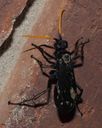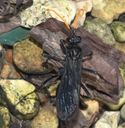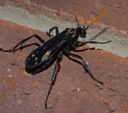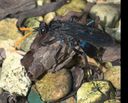Elegant Tarantula-hawk Wasp
Pepsis menechma
Classification
- Phylum: Arthropoda
- Subphylum: Hexapoda
- Class: Insecta
- Order: Hymenoptera
- Superfamily: Pompiloidea
- Family: Pompilidae
- Subfamily: Pepsinae
- Tribe: Pepsini
- Genus: Pepsis
- Species: menechma
Pronunciation
How to pronounce Pepsis menechma: /ˈpɛp.sɪs məˈnɛk.mə/
These audio files are automatically generated. While they are not always 100% accurate, they are a good starting point.
Images






Summary
Pepsis menechma is a species of spider wasp known for its diverse color forms and predatory behavior on large spiders. Commonly referred to as the Elegant Tarantula-hawk Wasp, it plays a role in the ecosystem by managing spider populations. It is found primarily in the eastern and central United States, with distinct physical characteristics that vary by region and form.
Physical Characteristics
Circa 20-25 mm in length. Body lengths for males range from 18-26 mm, and for females from 16-28 mm. There are three main forms: the western 'cerberus' form with orange wings and dark-bordered with dark antennae; the eastern 'elegans' form, which is blue-black with orange antennae; and the less common 'novitia' form, with orange wings and antennae that are mostly dark with some orange segments.
Identification Tips
Look for the coloration and size differences: the eastern form is blue-black with orange antennae while the western form has orange wings and dark antennae. The appearance of the third form can also indicate its identity with variations in wing and antenna coloration.
Habitat
Typically found in the eastern and central United States, particularly from Pennsylvania west to Kansas, and south to Florida and Texas. Also recorded from Arizona, Texas, Kansas, and into Mexico for the 'cerberus' form.
Distribution
Occurs throughout the eastern and central United States and parts of Mexico.
Diet
Adults take nectar, while females likely develop eggs as parasitoids on large spiders, such as trapdoor spiders and possibly tarantulas.
Life Cycle
Life cycle involves adult females laying eggs on or near the host spiders. The larvae will develop as parasites on these spiders, which may include tarantulas or trapdoor spiders.
Reproduction
Females deposit eggs presumably on or near large spiders. There are no concrete prey records for Pepsis menechma, but related species are known to prey on spiders.
Ecosystem Role
As parasitoids, Pepsis menechma plays a role in controlling spider populations, particularly within its host range.
Cultural Significance
Known as tarantula hawks, these wasps have cultural significance in areas where they are found, often due to their predatory behavior associated with tarantulas.
Evolution
Related species within the genus Pepsis have co-evolved behaviors and physical traits suited for hunting large spiders, with adaptations seen across different forms of the species.
Similar Taxa
Misconceptions
Commonly thought to primarily prey on tarantulas, Pepsis menechma may also focus on other types of spiders, particularly in regions where tarantulas are less common.
Tags
- Pompilidae
- Hymenoptera
- Parasitoid
- Spider Wasp
- Pepsis menechma